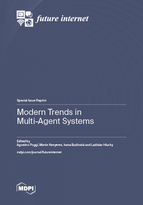Modern Trends in Multi-Agent Systems
A special issue of Future Internet (ISSN 1999-5903). This special issue belongs to the section "Smart System Infrastructure and Applications".
Deadline for manuscript submissions: closed (31 December 2022) | Viewed by 32276
Special Issue Editors
Interests: distributed systems; software engineering; multi-agent systems; agent-based simulation
Special Issues, Collections and Topics in MDPI journals
Interests: data aggregation; distributed computing; consensus; information fusion; multi-agent systems; wireless sensor networks
Special Issues, Collections and Topics in MDPI journals
Interests: applied informatics; discrete systems modeling and simulation; multi agent systems; artificial intelligence; ontology engineering
Special Issues, Collections and Topics in MDPI journals
Interests: grid architecture and grid computing; multi-agent systems and virtual networking; HPCN applications; parallel and distributed computing; architecture models; software technologies
Special Issues, Collections and Topics in MDPI journals
Special Issue Information
Dear Colleagues,
In general, the term "multi-agent system" (referred to as MAS) is understood as an interconnected set of independent entities that are able to effectively solve complex and time-consuming problems exceeding the individual abilities of common problem solvers. The coordinated entities forming MAS regularly interact with each other in order to solve various problems in numerous technical/non-technical applications. In many modern MASs, the entities are required to be fully autonomous, to provide global decisions based on local knowledge, and to be able to work effectively in a decentralized way. The design of robust, energy-efficient, and high-performance algorithms for MASs, therefore, poses a demanding challenge for the wider scientific community. Thus, significant attention has been paid by many scientists to optimizing the operation of MASs in many respects (e.g., routing, data aggregation, communication, coordination, consensus achievement, synchronization, etc.) over recent decades. This special issue is dedicated to the analysis and the optimization of MASs from a wide point of view (including also branches potentially applicable in MASs); therefore, potential topics include but are not limited to the following:
- wireless networks
- Internet of Things
- distributed and parallel computing
- cloud computing
- data aggregation, sensor fusion
- signal processing
- modeling by the big data from the multi-sensor systems
- possibility theory
- remote sensing data processing
- artificial intelligence for the multi-sensor fusion systems
- routing protocols
- communication protocols
- optical systems
Prof. Dr. Agostino Poggi
Dr. Martin Kenyeres
Dr. Ivana Budinská
Dr. Ladislav Hluchy
Guest Editors
Manuscript Submission Information
Manuscripts should be submitted online at www.mdpi.com by registering and logging in to this website. Once you are registered, click here to go to the submission form. Manuscripts can be submitted until the deadline. All submissions that pass pre-check are peer-reviewed. Accepted papers will be published continuously in the journal (as soon as accepted) and will be listed together on the special issue website. Research articles, review articles as well as short communications are invited. For planned papers, a title and short abstract (about 100 words) can be sent to the Editorial Office for announcement on this website.
Submitted manuscripts should not have been published previously, nor be under consideration for publication elsewhere (except conference proceedings papers). All manuscripts are thoroughly refereed through a single-blind peer-review process. A guide for authors and other relevant information for submission of manuscripts is available on the Instructions for Authors page. Future Internet is an international peer-reviewed open access monthly journal published by MDPI.
Please visit the Instructions for Authors page before submitting a manuscript. The Article Processing Charge (APC) for publication in this open access journal is 1600 CHF (Swiss Francs). Submitted papers should be well formatted and use good English. Authors may use MDPI's English editing service prior to publication or during author revisions.
Keywords
- multi-agent systems
- Internet of Things
- wireless sensor networks
- data aggregation
- remote sensing
- distributed computing
- parallel computing
- cloud computing
- artificial intelligence









